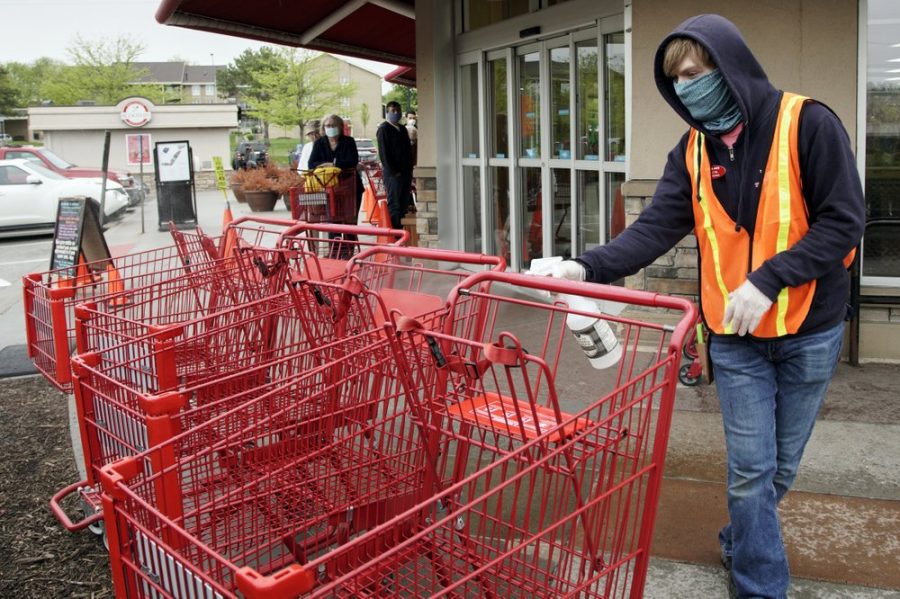EDITORIAL: Stay at home
Dilon Moore disinfects shopping carts and controls the number of customers allowed to shop at one time at a Trader Joe’s supermarket in Omaha, Neb., Thursday, May 7, 2020. Store workers across the country are suddenly being asked to enforce the rules that govern shopping during the coronavirus pandemic.
As various sporting and on-campus events resume across the state, many students return to in-person classes and the state government consistently presents misleading data, speculation about the proper precautions to take regarding the COVID-19 pandemic may seem increasingly understandable. Amid the increasing confusion, following the guidance of public health experts and officials becomes increasingly important, and their guidance is clear: Stay home if you are able; Wear a mask if you are not.
Although in many aspects of our lives and of our society we may attempt to return to some semblance of normalcy, we should not turn our backs to the reality of the pandemic. Millions of people are struggling across the country, and West Virginia is no exception.
Throughout the pandemic, essential workers and people of all backgrounds and professions have continued to risk their lives to prevent an absolute shutdown of the country and an even more devastating disaster than we face now.
As a people and as a society, we owe it to ourselves—especially to the most vulnerable amongst us—to do everything in our power to keep each other safe, and the least we can do toward that goal is to stay home when able and to practice social distancing and wear a mask when we must be in public.
Now is not the time to pretend we may return to “normal.” Now is anything but “normal.”
On a local scale, the Cabell-Huntington Health Department recently issued a stay at home order for Cabell County residents.
“The Cabell-Huntington Health Department is alerting the public of accelerated community spread of COVID-19, which is not improving with current actions,” a press release states. “Since our last advisory on October 1, Cabell County has seen further increase in infection rates and in daily percent positivity rates, despite increased laboratory testing and test availability. Widespread disease in the community increases exposure risk to the public, increases the risk of exposure to vulnerable populations, and reduces the effectiveness of contact tracing as a means of controlling disease spread. Widespread disease burdens individuals and families.”
As of Tuesday afternoon, Cabell County reports 1,165 confirmed coronavirus cases, more than 460 of which are currently active, with more than 45 additional probable cases. To date, 18 coronavirus-related deaths have been reported in the county.
On the Harvard Global Health Risk Levels map, Cabell County is categorized as red, reporting 28.9 daily new cases per 100,000 people. Per the Harvard metrics, a red categorization is called a “tipping point” at which “stay-at-home orders (are) necessary.”
Also Tuesday, Marshall reports 128 total confirmed campus cases, with 18 new cases since Oct. 6. University data show an average of 1.29 new campus cases per day for the past two weeks.
Statewide, West Virginia has reported more than 20,500 confirmed cases and more than 400 deaths. As of Tuesday, there were more than 5,100 active cases across the state and nine deaths reported in the last 24 hours.
The pandemic still is plaguing our country, our state, our county and our campus.
For the sake of keeping each other as safe as possible, we must follow the guidance of public health experts and officials, regardless of the positions of politicians or anyone else. Stay at home if you are able; Practice social distancing and wear a mask if you must be in public. If not for yourself, be responsible for those less fortunate and more vulnerable who may be put at increased risk of danger because of your actions.
Your donation will help continue the work of independent student journalism at Marshall University. If you benefit from The Parthenon's free content, please consider making a donation.







